P2568
Protect Your House from Termites
Contents
Termite Species in Mississippi
Distribution of Formosan Termites in Mississippi
Common Methods of Termite Control
Common Termite Treatment Questions
For most of us, our house is our largest single investment, and we want to keep it in good repair and protect it from threats. Termites are a major threat to Mississippi houses, and unprotected buildings are more likely to be damaged by termites than by fire or wind. Although it is rare for termites to completely destroy a building, repairing termite damage can easily cost tens of thousands of dollars. These pests occur throughout the state, and any building that contains wood or other cellulose components is susceptible to attack. Sooner or later, your house will probably be attacked and damaged by termites—unless you protect it properly.
This publication contains information that will help you protect your house from termites. First, it discusses the different species of termites that occur in Mississippi and how to determine which species threaten your house. Information on termite biology is also covered because understanding termite biology can help you better understand how to control these pests. The section on termite control covers the most common methods of controlling termites in pre-existing buildings and the relative merits of each, and provides answers to some of the most common questions homeowners have about termite control. The final section discusses some of the more common things that increase the risk of a house being damaged by termites.
Termite Species in Mississippi
There are three major species of termites in the state: eastern subterranean termites, Formosan subterranean termites, and southeastern drywood termites. All three species damage homes and other buildings, but their distribution varies. Eastern subterranean termites occur throughout the state. Formosan termites are spottily distributed in the southern half of the state, but they continue to expand their territory each year. Southeastern drywood termites are uncommon, with most infestations occurring in the three coastal counties.
Eastern subterranean termites (Reticulitermes flavipes) are our most common termites; they occur throughout Mississippi, and every wood structure in the state is at risk of attack by these termites. Actually, there are several species of Reticulitermes termites in the state, but their biology and damage is so similar that they can be considered as one for our purposes. R. flavipes is by far the most common Reticulitermes species. These termites are a natural and important part of the ecosystem in Southern forests, where they help recycle fallen trees and limbs. It is only when they enter our wooden buildings or damage other structures that these termites become pests. Unfortunately, this is something they will readily do. Eastern subterranean termites are very susceptible to desiccation and must maintain contact with the soil, or some other ready source of moisture, in order to survive. This is one of the weak links in termite biology that we exploit in their control.
Formosan subterranean termites (Coptotermes formosanus) are a non-native, invasive species that was first found in the state in 1984. They now occur in at least 26 Mississippi counties (Figure 5) and are especially common in the coastal area. This is a subterranean termite that, like the eastern subterranean termite, nests in soil and forages on available wood. Well-established colonies of Formosan termites use a mixture of saliva, mud, and digested wood to build nests, known as carton nests, in walls and other voids in infested buildings. In humid environments, this carton can absorb enough moisture from the air to sustain a colony. This ability to survive without having direct contact with soil is one of the key differences between Formosan and eastern subterranean termites. Formosan termites also are larger, forage more aggressively, develop much larger colonies, and consume more wood per termite. This means Formosan termites are capable of causing greater damage in a shorter period of time. Formosan termites also are much more likely to invade living trees and will even attack trees, such as cypress, that are immune to eastern subterranean termites. Formosan termite infestations in trees are an important problem in the coastal area of the state.
Southeastern drywood termites (Incisitermes snyderi) occur primarily in the extreme southern part of the state, mostly along Highway 90. These termites are so named because they do not have to maintain contact with soil or another source of moisture in order to survive. They live in dry wood timbers. Drywood termite treatment is much different than that for other termites, so it is important to be sure of the identification before treating. Drywood termite swarmers superficially resemble Formosan termite swarmers, and these two species are sometimes misidentified. Depending on the extent of infestation, treatment for drywood termites can range from removing or treating a few infested timbers to tenting and fumigating the entire building. Occasionally other species of drywood termites are brought into the state in infested furniture or other wood products. Infestations of drywood termites are relatively uncommon, even in the coastal area, and the remainder of this publication focuses on the two subterranean species.
Termite Biology
Termites have a gradual life cycle, hatching from eggs, which are laid by the queen or by secondary reproductives, into nymphs. The nymphs gradually develop into adult termites, most of which are workers. There are several castes (Figure 1), but workers are by far the most numerous. Depending on species, about 1 in 50 to 1 in 10 of the termites in a colony are soldiers. Soldiers have enlarged, darker-colored heads armed with strong mandibles, which they use for protecting the colony. In addition to the founding queen and king, mature termite colonies also contain many secondary reproductives, and it is the combined egg production of these secondary reproductives that accounts for most colony growth. Mature colonies produce hundreds to thousands of winged swarmers once each year, which leave the colony and attempt to start new colonies of their own.
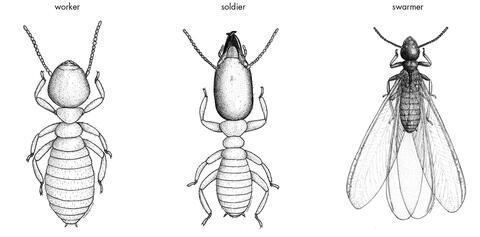
Termite colonies begin when a pair of swarmers settles to the ground after the mating flight. The two swarmers find a crevice in the soil, seal themselves in, and mate. The young queen lays her first eggs, which hatch into nymphal workers. These first workers forage on cellulose material in the immediate area. This could be decaying bits of wood, mulch, leaves, or pine needles. Recent research has found that pine needles are one of the best food sources for Formosan termite colonies. As more workers are produced, they expand the nest galleries and forage farther from the colony for food. New termite colonies grow slowly. After the first year a newly founded colony may contain only around 50 to 100 termites, and there may be only a few hundred after 2 years. It typically takes at least 3 to 5 years for a colony to grow large enough that it may be able to invade a building or produce swarmers of its own.
Termite workers are entirely white, soft-bodied, and blind. They are highly susceptible to desiccation and shun exposure to light and open air. This is why termites must maintain contact with moist soil or some other constant source of moisture. Subterranean termites forage by building underground tunnels that radiate away from their nest site. They cannot sense the presence of wood or cellulose from any distance; they detect suitable food sources largely by random foraging. Once they locate a suitable food source, they establish foraging tunnels to the source and exploit it for as long as it lasts. When termites are forced to travel over an exposed hard surface, such as rock, brick, treated wood, or a concrete foundation, they build mud tubes to maintain their moist, protected environment. These mud tubes are one of the more obvious signs of termite infestation, but they are not always present or visible.
Swarming
Swarming is the main way termites reproduce and begin new colonies. It takes several years for a colony to become large enough to produce swarmers. These winged swarmers are unmated male and female reproductive forms. A healthy, well-established colony of subterranean termites can produce hundreds to thousands of swarmers.
Through most of the year, a colony of termites goes about its daily business in out-of-the-way, unseen places, tunneling through the soil and feeding on wood or other cellulose products. Normally, termites shun light and quickly plug any holes or accidental openings to the outside world. However, on “swarming day” the worker termites intentionally open holes to the outside, and the young swarmers emerge together to fly and be carried by wind to another location. The plan is to pair up with a member of the opposite sex, fall to the ground together, shed the wings, mate, find a protected site in the ground, and begin a new colony.
Unlike fire ants, which mate in the air, leaving the newly mated queen to start a new colony alone, newly paired termites found a colony together—queen and king. However, the vast majority of termite swarmers die without fulfilling this goal. This is especially true for swarmers that emerge inside a building, because they will soon die without access to moist soil.
Eastern subterranean termites and Formosan subterranean termites swarm at different times of the year, and the swarming habits of these two groups must be discussed separately:
Eastern subterranean termites in Mississippi will typically swarm from mid-February to mid-May, normally during the morning hours. As these termites swarm during the day, light will not attract them to your house. If these swarmers are encountered indoors, it is very likely that your house is infested, and you should reach out to a qualified pest management company.
Formosan subterranean termites in Mississippi usually swarm from early May into early June. Having Formosan subterranean termite swarmers indoors is justification for having the building treated, or making sure the building has already been properly treated and is under contract. As this species swarms at night and is attracted to light, they are often encountered around light poles and other sources of light visible outdoors at night.
In areas with Formosan termite activity, it is possible to encounter low numbers (dozens) of these swarmers indoors, even in homes that have been properly treated. These instances are typically associated with light visible from the exterior of a building at night attracting them, and the swarmers find their way in through an open door or other gaps. In this situation, the house may not necessarily be infested; however, it does suggest that there are active Formosan termites nearby. Homeowners should verify that an active termite contract is still in place and notify the company; if an active contract is not in place, reach out to a qualified pest management company to request an inspection. Large numbers (hundreds or more) of Formosan swarmers found indoors should trigger an in-depth inspection by a professional.
Depending on species, location in the state, and environmental conditions, swarming times will vary. Regardless of species, if you see swarmers actively emerging indoors, it is a sure sign that the structure is infested.
Termites or Ants?
Although swarming termites may resemble winged ants superficially, a close examination reveals several major differences (Figure 2). Ants have elbowed antennae; narrow, wasp-like waists; and hind wings that are shorter than the forewings. Termite swarmers have straight, bead-like antennae and broad waists. Their hind wings and forewings are the same length.
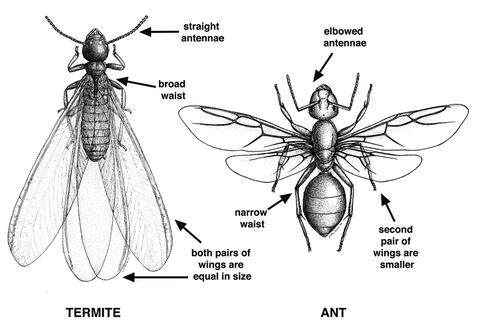
Identifying Termite Species
It is important to know which species of termite you are attempting to control because control options vary depending on species. Although they are the most abundant caste, workers of all three termite species are similar in appearance and are difficult, if not impossible, to identify. Fortunately, there are several differences in swarmers and soldiers (Figures 3 and 4), as well as in behavior, that allow for ready identification. See Table 1.
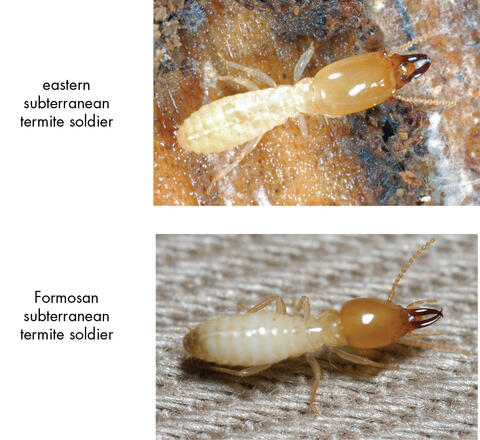
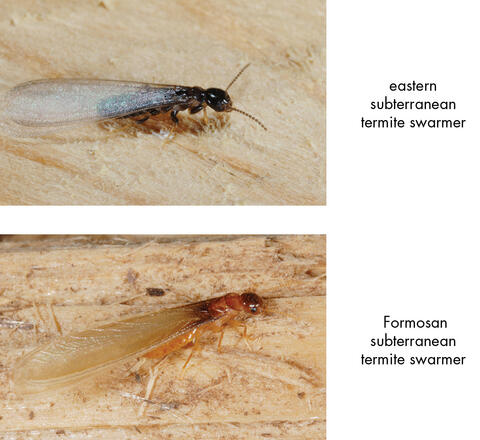
|
Trait or Habit |
Eastern Subterranean Termite |
Formosan Termite |
Drywood Termite |
|
Distribution |
Statewide |
Southern half (see map) |
Mostly along coast |
|
Appearance of soldiers |
Rectangular head; no teeth on mandibles |
Teardrop-shaped head; no teeth on mandibles |
Boxy, rectangular head; heavy teeth on mandibles |
|
Abundance of soldiers |
About 1 per 50 workers |
About 1 per 10 workers |
– |
|
Color of swarmers |
Dark brown to black |
Yellow to golden brown |
Yellow to brown |
|
Length of swarmers, including wings |
3⁄8 inch |
½ inch |
7⁄16 inch |
|
Swarms (time of year) |
February to May |
May to June |
May to June |
|
Swarms (time of day) |
Day, usually morning |
Dusk to midnight |
Dusk |
|
Builds mud tubes |
Yes |
Yes |
No |
|
Produces piles of dry fecal pellets |
No |
No |
Yes |
|
Tunnels in wood galleries contain dry soil |
Yes |
Yes |
No |
|
Forms aerial colonies (not requiring contact with soil) |
Rarely (requires structural or plumbing leak to sustain an aerial colony) |
Often (if a mature colony builds aboveground carton nest, or if there are structural or plumbing leaks) |
Always (does not require constant moisture source) |
Distribution of Formosan Termites in Mississippi
As of April 2024, established populations of Formosan termites were known to occur in 26 Mississippi counties (Figure 5), all of which are in the southern half of the state. Formosan termites are especially common from Hattiesburg south, often overshadowing eastern subterranean termites in frequency of infestation. Some infested counties farther north in the state have only a few detections of Formosan termites that are isolated to only a portion of the county. Formosan termites continue to spread within the state, and it is likely that undetected infestations exist in other counties. Within the past 10 years, isolated infestations were detected in or near Starkville, Columbus, Louisville, Olive Branch, Tupelo, and Oxford, but there have been no indications that infestations persist in the surrounding landscape following treatment of infested buildings. In 2018 and again in 2019, isolated infestations were detected and treated at two different locations in Columbus. In each of these five cases, there was evidence of infested wood products having been brought in from another location. In 2020, Formosan termites were reported and treated in a home in Olive Branch, and two isolated cases in Oxford were investigated, with one being an infestation that was treated.

Signs of Termite Infestation
Termites work quietly inside walls, floors, and attics, and because of their secretive nature, a building can be infested for quite a long time before the problem is detected (Figure 6). This is why it is best to go ahead and take preventive action, rather than wait until you have damage. Still, it is important to be aware of the signs of termite infestation because even buildings that have been treated can become infested. Some of the most common signs of termite infestation are listed in Table 2.
|
Sign |
Comments |
|
You see swarmers emerge inside the house, or you find large numbers of dead swarmers on the floor or windowsill. |
This is a sure sign the building has an active termite infestation. Start getting bids/inspections. |
|
You see swarmers emerge outside from a stump, wood pile, or other source very near the building’s foundation. |
This may or may not mean the building is infested, but it is definitely cause for further investigation. Get a professional inspection. If you do not know when the building was last treated, it would be a good idea to get it treated. |
|
You see swarmers emerge outside from a stump, fallen log, pile of wood, or other source well away (about 25 feet or more) from the building, or you find active termites in such a situation. |
This is rarely cause for concern. It is normal for termites to be in these types of situations. Still, if you do not know when the building was last treated, this should serve as a reminder to have it inspected. Do not worry about trying to control these termites “before they get to the house.” Just make sure the house is properly protected. |
|
You find mud tubes traveling up the outside foundation wall, inner foundation wall, up support piers or plumbing under the house, etc. (Note that simply destroying these tubes will not control or deter the termites.) |
Such tubes are usually a sure sign of termite infestation. Carefully break a 1-inch section of the tube and watch to see if you observe termites or if they repair the tube over the next few days. Unless you know these are old tubes from a previous infestation, get a professional inspection whether you see termites or not. |
|
You notice a BB-sized spot of dried mud on an inside wall or ceiling of sheetrock, wood paneling, or other wall covering. (Scrape away the mud and watch closely to see if a termite comes to investigate. Mark the spot and note whether it is repaired over the next few days.) |
These are known as “pin-holes” in the pest control trade. They occur when termites accidentally cut an opening to the outside, which they promptly repair with mud because they do not like the light and air flow. Get a professional inspection. |
|
You notice narrow, sunken, winding lines in wallpaper, paint, or other surfaces. |
This could be due to termite galleries located just beneath the surface. Note that termites do not eat the gypsum core in sheetrock, but they readily eat the outer cardboard covering. Get a professional inspection. |
|
You notice odd-shaped formations of dried mud sprouting from walls in the spring. |
These are probably “swarm castles” built by Formosan termites in preparation for swarming. Start getting bids/inspections. |
|
You encounter termite damage when removing wallpaper, doing home repairs, or remodeling. |
If you actually see termites, you know this is an active infestation. If there is dried mud in the galleries, this is a sign of termite damage, but if no termites are present, this could be old damage from an infestation that was controlled at some time in the past. Get a professional inspection. |
|
You notice structural problems such as a sagging floor or roof, or more obvious problems like a broken door frame. |
This could be due to wood rot or other causes, but if you find damaged timbers with galleries containing dried mud, this is termite damage. If you actually see termites in the damaged wood, you know this is an active infestation. Get a professional inspection. |


Termite Control
Termite control is best done preventively! Ideally, you want to treat before termites get into the building and cause damage, but it is often necessary to treat because a building is already infested. Termite treatments can be divided into two broad categories: preconstruction and postconstruction. Preconstruction treatments are always preventive treatments, but postconstruction treatments can be either preventive or corrective. This publication focuses on postconstruction termite protection and attempts to answer some of the most common questions homeowners have about these treatments. For more information on preconstruction termite treatments, see Extension Publication 2765 What Homebuilders Need to Know about Termites.
Currently, there are two basic options for postconstruction termite control: liquid termiticide treatments and termite bait stations. The baits are a relatively recent innovation, with the liquid termiticides being the more conventional treatment.
Liquid Termiticide Treatments
Liquid termiticides are applied by trenching, rodding, and/or drilling around the building and treating the soil with a liquid termiticide to create a zone of insecticide-treated soil approximately 1 foot wide around the foundation of the building. (Treated trenches must be a minimum of 4 inches wide, but termiticide migrates into nearby soil.) Foraging subterranean termites attempting to invade a structure will be exposed to this zone of treated soil and die (Figure 7). In most cases, it will also control termites that have already infested the building because they must travel through this treated soil when they return to the soil for moisture. Unless they have already established a carton nest or have some other aboveground source of moisture, even Formosan termites must return to the soil.
Depending on how the building is constructed, it is sometimes necessary for the technician to drill through the flooring and slab on the interior and inject termiticide. It is also necessary to treat bath traps, and this usually means the technician must enter the building, cut or drill through a wall to access the bath trap, and treat the exposed soil with a small amount of termiticide. For buildings with crawlspaces, the technician must crawl under the house and trench and treat around all support piers. With most termiticides, the technician will need to trench and treat along the inside of the foundation wall in crawlspaces. In some cases, it is also necessary to drill horizontally through brick and other types of masonry and inject termiticide into voids through which termites may enter.
The liquid termiticides on the market today are quite effective and most provide many years of residual control of both eastern subterranean termites and Formosan termites. Of course, any activity that disturbs the zone of treated soil will create a potential point of entry for termite infestation. Examples of such activities include digging flower beds too near the building, piling mulch or leaves against the building, treated soil being washed away from the building, untreated soil being washed against the building, stacking firewood against the building, and adding untreated wood structures (trellises, planter boxes, steps, etc.) to the building.
Termite Bait Stations
In-ground baits consist of bait stations placed in the ground at regular spacings around the perimeter of the building. The bait consists of a material that is highly palatable to termites and is impregnated with a slow-acting insect growth regulator insecticide. Foraging workers carry this baited material back to the colony where it is shared with other colony members, eventually resulting in control. Because insecticides used in baits are slow acting, it can take several months to obtain control of active infestations with bait stations alone. Bait stations must be inspected regularly so depleted stations can be refilled and damaged stations replaced. The frequency of inspection ranges from annually to quarterly, depending on the product used.
Bait stations can be used for preventive or corrective treatments, but when used on buildings with active termite infestations, bait stations are often used in combination with spot treatments of liquid termiticides. The liquid termiticides are applied to those areas of the building where termite infestations are known to exist in order to hasten control.
Aboveground bait stations are also available and can be used to treat aboveground colonies as an alternative to foaming. Aboveground stations are installed at sites of known, aboveground termite activity in such a way as to encourage termites to begin feeding on the bait inside the station. When using aboveground bait stations, it is important to avoid using any other insecticide around the site to avoid repelling termites from the bait stations and interfering with control. Although aboveground bait stations are slow acting, they are sometimes able to eliminate termites from aboveground sites that cannot be detected and treated with foam treatments. This is because termites that are feeding on aboveground bait stations may share the bait with termites feeding in these other areas where they are not detectable or accessible. Aboveground bait stations are rarely used alone and are primarily used as supplemental treatments with either in-ground bait stations or liquid soil treatments.
Termiticide Foam Treatments
Foams are specialized treatments used by pest control technicians to apply termiticides into wall and other structural voids where termite infestations are known or suspected to occur. The termiticides used in foam treatments are some of the same products used as liquid termiticide treatments, but they are mixed with a special additive and applied with special equipment, resulting in foam with a consistency similar to that of shaving cream. When injected into structural voids, this foam spreads in all directions, filling the void and drying to leave a termiticide residue inside the treated void.
Foam treatments are used primarily as spot treatments to treat infested areas of a building and to supplement and hasten the control provided by liquid termiticide soil treatments or baits; they are not used as stand-alone treatments. Foam treatments are especially useful for treating aerial colonies of Formosan termites. Locating and foaming any aboveground colonies or treating such colonies with aboveground bait stations is an important part of treating an active infestation of Formosan termites. It sometimes takes months or even more than a year, and several return visits by the technician, to detect and treat all aerial colonies in a building that was heavily infested with Formosan termites.
Common Methods of Termite Control
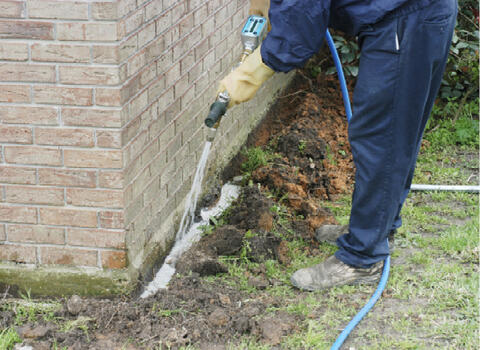
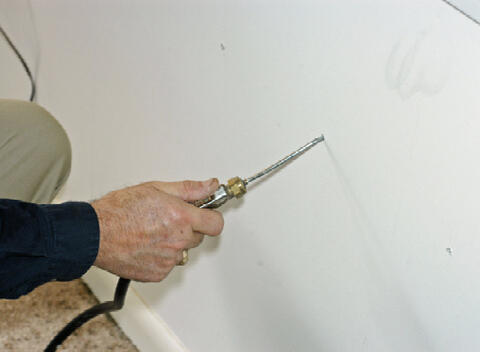
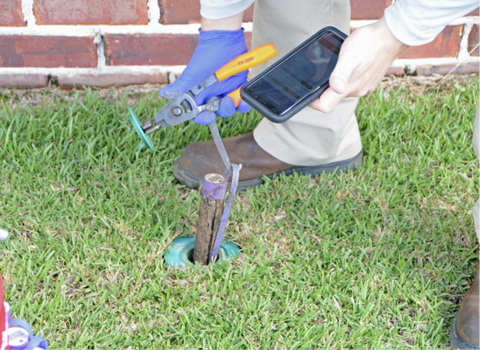
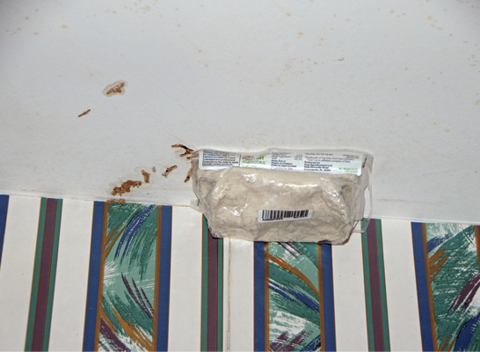
Common Termite Treatment Questions
Which treatment option is best, the bait or the liquid termiticide?
Both the liquid termiticides and the in-ground baits are capable of providing effective, long-term termite control. The baits have the advantage of using far less total insecticide and of being able to provide control in environmentally sensitive or hard-to-treat situations. However, baits are much slower-acting than liquid termiticides, and it can take months to a year or longer to eliminate an active termite infestation using baits alone. Also, baits will work only if stations are properly maintained and checked regularly. Liquid termiticides offer quicker control with fewer service visits, and this often results in less cost in the long run. One of the key advantages of liquid termiticide treatments is that, once properly applied, they will usually continue to provide years of effective termite control without further maintenance—even if the termite contract is not renewed. This is not true for the in-ground baiting method, which must be serviced at least yearly to remain effective. If the contract is allowed to lapse when using bait stations, the bait stations will be removed, and the building will be left without termite protection.
What liquid termiticides are used today and how long do they last?
Currently, there are several active ingredients approved for use as liquid termiticides. These include fipronil (Termidor), imidacloprid (Premise), and several pyrethroid insecticides, such as bifenthrin (Talstar), cypermethrin (Prevail), and permethrin (Dragnet). Termiticides are subjected to rigorous, long-term testing by the U.S. Department of Agriculture Forest Service at four field locations in the United States. In general, products must provide 100 percent control for a minimum of 5 years in order to be labeled, but there have been some exceptions. As of the end of the 2015 testing season, the better termiticides have provided 100 percent control for 11 to 12 years in the USDA Forest Service trials in Mississippi. Termiticides do break down over time, and even the best termiticide cannot provide protection if the treated soil barrier around the foundation is disturbed in some way.
What if I have Formosan termites?
Although there are some key differences in the biology, behavior, and damage potential of Formosan and eastern subterranean termites (Formosans tend to form larger colonies and are generally more damaging), control options are similar. The insecticides and treatment methods used to control eastern subterranean termites will work equally well on Formosan termites. The only real difference is that Formosan termites are much more likely than eastern subterranean termites to have aerial colonies, relying on either their carton nest material or some plumbing or structural leak as a source of moisture. This means they may not have to travel back to the soil to obtain moisture and they are not always controlled by a typical soil-applied termiticide barrier treatment.
It is still important to apply a liquid termiticide soil treatment or install in-ground bait stations when treating for Formosan termites, but it is also important to find and treat any aboveground colonies. This is usually done by using a termiticide foam to treat wall, floor, or ceiling voids where such colonies occur, or by installing aboveground bait stations. Professional pest control technicians are aware of this tendency of Formosan termites to form aerial colonies and have the equipment and experience needed to find and treat such colonies. However, aerial colonies are difficult to detect, and it is not practical to preventively treat an entire building for aerial colonies. It can take several repeat visits by the termite technician to find and eliminate all aerial Formosan colonies. This is one reason it is especially important to keep your termite contract in force if you live in an area where Formosan termites occur.
I found swarmers! Does this mean my house is infested with termites?
If the swarmers actually emerge inside the house, or if dead swarmers are found inside the house, then the building definitely has an active termite infestation (see exception below). If swarmers are observed emerging just outside the house, within 10 feet or so of the foundation, then the home may be infested, but not necessarily. If the house has been properly treated, the swarmers could just be coming from a stump or other nearby outside wood source. Termites are a natural and beneficial part of the forest ecosystem. They are present in every wooded environment in the state, including home landscapes, and seeing a swarm emerge from a stump or other site located some distance from the house is not cause for alarm. However, if you do not have a current termite contract and do not know when the building was last treated, seeing swarmers anywhere in the landscape is a good reminder that you need to take action.
I live in South Mississippi and found a dozen or so Formosan swarmers in my living room in May. Does this mean my house is infested?
Not necessarily. Finding eastern subterranean termite swarmers or large numbers of Formosan swarmers inside is a sure sign a building is infested, but because Formosan termites swarm at night and are attracted to light, finding a small number of swarmers inside does not necessarily mean the building has an active infestation. These few swarmers could have simply flown through an open door or window or ridden in on someone’s clothing. However, finding more than a few dozen Formosan swarmers inside should be viewed as cause for further investigation. The bottom line here is that if you live in an area where Formosan termites are this common, you should already have your house protected. If not, then let these swarmers serve as a reminder.
There is also a small possibility that these are drywood termite swarmers. Drywood termite swarmers are also golden brown and swarm about the same time as Formosans. Drywood termite infestations are not common, but homeowners living along the Gulf Coast need to be aware of the potential for drywood termite infestations.
I haven’t seen any swarmers. Does this mean my house is not infested?
Not necessarily. Observing swarmers is only one means of discovering an infestation. By their very nature, termite infestations are cryptic and difficult to detect. Although termite colonies swarm only 1 day a year, swarmers are one of the most easily observed signs of infestation. Other signs of termite infestation include exposed mud tubes; pinholes in sheet rock, paneling, or other wood surfaces; sunken “trails” in walls or ceilings, indicating the presence of termite tunnels just below the surface; accumulations of soil on windowsills or along baseboards; and detection of damage to wood, books, or other cellulose products.
What should I do if I observe a swarm in or near my house or if I have some other reason to suspect an infestation?
If you already have an active termite contract with a pest control company, contact the company; tell them what you observed and where you observed it, and request a follow-up inspection. Depending on the contract, the company will usually provide any additional needed treatments at no additional cost. If you do not have a current termite contract on your home, contact a local pest control company, tell them what you have observed, and request an inspection and a bid for any necessary treatment.
How much will it cost to have my house treated for termites?
Depending on the size of the home, the type of foundation, and how the home is constructed, termite treatment costs can range from around $800 to several thousand dollars. Pest control companies performing work in Mississippi must be licensed by the Mississippi Department of Agriculture. Mississippi has many high-quality pest control companies, but the cost of treatments and the type of service can vary considerably among companies, and it is a good idea to get bids from several different companies.
Keep in mind that price and quality of service are not necessarily closely correlated, and the lowest bid may not always be the best bid. Also realize that there is a lot involved in treating for termites, and quality service and treatment are not cheap. Be sure to ask questions and understand exactly what you are getting when you buy a treatment and termite contract. In addition to the original treatment cost, most companies charge an annual renewal fee to keep the contract in place from year to year. The cost of an annual inspection is included in this renewal fee. Depending on the details of the contract and size of the home, renewal fees can range from around $125 to several hundred dollars.
If my building sustains termite damage while under a contract, will the company pay for the repairs?
This depends on your contract, but probably not. Most contracts today only provide for retreating the structure in the event it becomes reinfested while under contract, but some companies still offer damage repair contracts as an additional option. Contracts that cover damage repair and retreatment are usually more costly than those that provide only for retreatment. Be sure to read contracts carefully and understand what you are getting—before you commit.
Can I save money by treating my home myself?
No! Although there are products available to homeowners for control of termites, treating your house for termites is not a do-it-yourself project. Most of the insecticides professional pest control companies use to treat termites are not readily available to the general public. This is especially true for the longer-lasting, more effective products. Even with the proper insecticide, few homeowners have the training and specialized equipment needed to properly apply termite treatments. One of the main problems with do-it-yourself treatments is that it usually takes several years to find out that the treatment was not effective. Having a building professionally treated for termites is costly, but it is far less costly than having to repair major termite damage because of an ineffective do-it-yourself treatment. You might consider using one of the do-it-yourself products to treat a storage shed, a dog house, or some other small, stand-alone structure, but get a professional to treat your house!
Should I pay the renewal fee each year?
After you have spent the money for the initial treatment, it is usually a good idea to pay the renewal fee each year to keep your contract in force and get the annual inspection. Read your contract carefully to see exactly what protection and services you are getting for the renewal fee and how much the renewal fee is. Then make an informed decision based on the potential risks and benefits. You definitely need to pay the annual renewal fee and keep the contract in force when using the in-ground bait stations because termite protection ceases as soon as service visits cease. It is also an especially good idea to keep your contract in force in areas where Formosan termites are present because of their more aggressive foraging behavior and tendency to establish aerial colonies.
I just found termites in my house. How much time do I have to do something?
If your house is infested with termites, it is critical, but not urgent, that you have the building treated to eliminate the infestation. It takes several years for a colony of termites to grow large enough to invade a building and produce swarmers. If you have found an infestation or had a swarm emerge in or near your house, the colony has been there for several years. Taking a month or two to get the home inspected and get bids from several companies won’t result in that much additional damage, and you may get a better treatment at a lower price.
We are buying an existing home; what do we need to know and do about termites?
When existing homes are sold in Mississippi, most lenders require a “wood-destroying insect report” (WDIR) or “termite inspection.” A trained termite technician will conduct the inspection, then file a report of the findings. If termites are found during the inspection, it is recommended that the building be properly treated, and if “conducive conditions” are noted, it is wise to have them corrected. It is important to understand that when the WDIR indicates that no termites were found, this does not necessarily mean the building is free of termites. It only means a trained technician inspected the building for termites and other wood-destroying organisms and did not find any. By their very nature, termite infestations are cryptic and difficult to detect, and short of dismantling the building piece by piece, it is impossible to be absolutely sure whether or not a building is infested.
When purchasing an existing home, it is a good idea to visit with the previous owner about the history of the building. When was it built? When was it last treated for termites and what termiticide was used? Has the building ever been infested? Is the home currently under a termite contract? If the home is under a termite contract, it is a good idea to check with the pest control company to see if they will allow you, as new owner, to assume the contract by paying the next annual renewal fee. If it has been several years since the home was treated for termites, if it was treated with one of the less effective termiticides, or if the previous owner does not know when the home was last treated, then it is a good idea to have the home retreated. If it is not possible to visit with the previous owner and a real estate broker is handling the sale, a property condition disclosure statement is required through the Mississippi Real Estate Brokers Act of 1954. The property condition disclosure statement requires the seller to disclose known problems, including any evidence of rot, mildew, rodent infestation, or wood destroying insect infestation, if any treatments were made, if the damage was repaired, and if the structure is currently under a termite contract.
We are building or buying a newly built home. What steps should we take to be sure it is properly protected from termites?
When building or purchasing a newly built home, where you will be the first owner, it is important to be sure the termite pretreatment was or is applied properly. Pretreatments are done in two steps. The first step is to apply termiticide to the soil underneath the building before the slab is poured, or to treat the lower 2 feet of the wall studs and base plates with an approved borate product before the interior insulation and wall covering is installed. The final step is to apply termiticide around the perimeter of the building after all construction and initial landscaping is complete.
The pest control company doing the pretreatment has up to 1 year after the building is completed to apply this final perimeter treatment. As a new homeowner, you want to be sure this final treatment gets done, and you need to know what termiticide is used. Beginning in 2009, Mississippi pest control companies are required to place a sticker on the exterior electrical box showing the date when this final perimeter treatment was applied and what company applied the treatment. If you purchase a new home before this final perimeter treatment is done, check with the builder and get the name and contact information of the pest control company that was contracted to do the pretreatment. See Extension Publication 2765 What Homebuilders Need to Know about Termites for additional information on termite control for new construction.
Common Termite Risk Factors
Even if your house is properly treated for termites, there are many things you can do, or allow to occur, that increase the risk of termites invading your home. Knowledge can help you avoid these common problems. Here are some general points to keep in mind:
- It is important that the house be properly treated and that any new addition be properly treated.
- Any activity that disturbs the band of treated soil around the outside of the house will increase the risk of attack. This includes any activity that moves treated soil away from the area or any activity that moves soil, mulch, leaf litter, or pine straw over the treated band of soil.
- Any activity that destroys or disturbs bait stations will result in areas that are not properly protected.
- Any activity that results in soil, mulch, or leaves being in contact with any wood part of the house or with siding or insulation will provide a ready entry point for termites.
- Excessive water accumulating against the foundation or over the treated soil can leach, break down, or wash away the termiticide or interfere with bait stations. This can be water from poor drainage, gutter downspouts, air conditioner condensation, leaky faucets, or excessive irrigation.
- Moist, rotting wood is a major predisposing factor for termite infestations. This is true whether the moisture results from leaks in roofs, flashing, or other structural components; from plumbing leaks; or from moisture condensation due to poor ventilation.
Following are some specific examples of risk factors for termite infestation:
- Not having the building properly treated for termites.
- Not having the building annually inspected for termites.
- Adding onto a building and not having the addition treated.
- Adding a patio or deck and not having the area retreated.
- Adding a trellis, steps, or other wood structure using untreated wood.
- Allowing soil to contact siding or any wood portion of the house. Ideally, there should be at least 6 inches of clearance from soil to the lower edge of the siding.
- Inadequate ventilation under houses with crawl spaces.
- Digging or tilling in the treated soil band.
- Adding raised flowerbeds against the outer wall of the house.
- Damage or destruction of bait stations that create gaps in termite protection around a building.
- Stacking firewood or lumber against the house.
- Piling mulch against the foundation.
- Allowing leaves or pine straw to accumulate against the house.
- Planting shrubs or flowerbeds too near the foundation, making inspection difficult.
- Trees growing too near the house, where roots can grow under the foundation.
- Soil being washed away from or against the foundation.
- Removing or replacing treated soil when installing plumbing or other utilities.
- Dogs or other animals digging in the treated soil band.
- Water from the roof or downspouts dripping onto the treated soil band.
- Water from air conditioners or leaky faucets dripping onto the treated soil band.
- Excessive irrigation water leaching through the treated soil band.
- Poor drainage, allowing water to pool against the foundation.
- Moist wood due to plumbing leaks, structural leaks, or condensation. Leaks and moisture problems are major termite risk factors!
For More Information
MSU Extension Publication 2765 What Homebuilders Need to Know about Termites
This work is partially supported by Crop Protection and Pest Management, Extension Implementation Program, award no. 2021-70006-35580 from the USDA National Institute of Food and Agriculture. Any opinions, findings, conclusions, or recommendations expressed in this publication are those of the author and do not necessarily reflect the view of the U.S. Department of Agriculture.
The information given here is for educational purposes only. References to commercial products, trade names, or suppliers are made with the understanding that no endorsement is implied and that no discrimination against other products or suppliers is intended.
Publication 2568 (POD-04-24)
By J. Santos Portugal III, PhD, Assistant Extension Professor, Blake Layton, PhD, Extension Entomology Specialist, and Joe MacGown, Research Technician/Scientific Illustrator, Biochemistry, Molecular Biology, Entomology, and Plant Pathology.
The Mississippi State University Extension Service is working to ensure all web content is accessible to all users. If you need assistance accessing any of our content, please email the webteam or call 662-325-2262.
